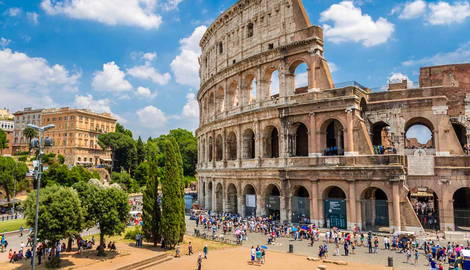
The Colosseum is the quintessential symbol of Rome, representing the city’s incredible history as the heart of the Roman Empire. Once the greatest amphitheater in the world, it was the place where terrifying gladiatorial fights and monumental naval battles played out to a live, captive audience of people from all walks of life. Today it is a top tourist attraction, drawing in more than 6 million people who marvel at its vast, impressive structure and monumental historical significance. Because of this, it was recently voted one of the modern seven wonders of the world, and has become a protected UNESCO World Heritage site. We take a look through the top reasons why the Colosseum should be high on your bucket list of places to visit.
1. The Colosseum Is One of the Oldest Structures in the World

In spite of being over 1,900 years old, the Colosseum still stands tall over the city of Rome today. Commissioned by Emperor Vespasian in 72 CE and completed by his son Titus in 80 CE, the Colosseum has survived earthquakes, fires and stone robbery, with enough of the original monument intact for audiences to imagine how it would have appeared during ancient times. History buffs and novices alike trek to this ancient construction to marvel at the weight of history hidden within its walls, from terrifying battles to fearsome gladiatorial fights. It represents the impressive architectural engineering skills of the Romans, who designed its multi-layered tiers to carry a vast volume of spectators seated around its circular arena, with each level reserved for a different class of Roman society.
2. It Is Largest Amphitheatre in the World

Romans designed and built a series of amphitheaters throughout the Roman Empire, but the Colosseum was the largest and most popular of them all. Even today, it is still the largest amphitheater in the world, despite being nearly 2,000 years old. In fact, the site covers 5 acres of land, is 612 feet long, and 515 feet wide. During its heyday the spectacular venue could hold audiences of up to 70,000 people. 100,000 cubic meters of travertine stone mined from the quarries at Tivoli would have been hauled into place by the Romans to piece together with many thousands of iron clamps and concrete.
3. The Colosseum Is an Incredible Feat of Engineering

Given its sheer scale, and the fact that much of the original building still remains, the Colosseum is undoubtedly a testament to the architectural and engineering skills of the Romans, whose ideas continue to inform the way buildings are constructed today. In fact, experts agree the reason the Colosseum is still standing today is because of its robust concrete foundation which holds the building’s complex system of archways in place.
4. A Reminder of Gladiatorial Fights and Naval Battles

The Colosseum is a clear reminder of the terrifying events that would once have played a central role in Roman society. It is hard for us to imagine just how spectacular and gruesome they would have been, including gladiatorial fights, dramas based on Classical mythology, mock naval battles, wild beast hunts, battles reenactments and chariot races. Romans loved the weird and wonderful range of events staged here, returning again and again to fill up its seats.
5. A Symbol of Ancient Imperial Rome

The Colosseum is one of the best-preserved monuments from ancient imperial Rome, and it speaks of the weight of human history bound into its hefty stone walls. It can be recognized today as a symbol of the glory days before the Roman Empire collapsed, when they ruled over much of the ancient world and populated great swathes of the western world with their sophisticated architecture and engineering.










